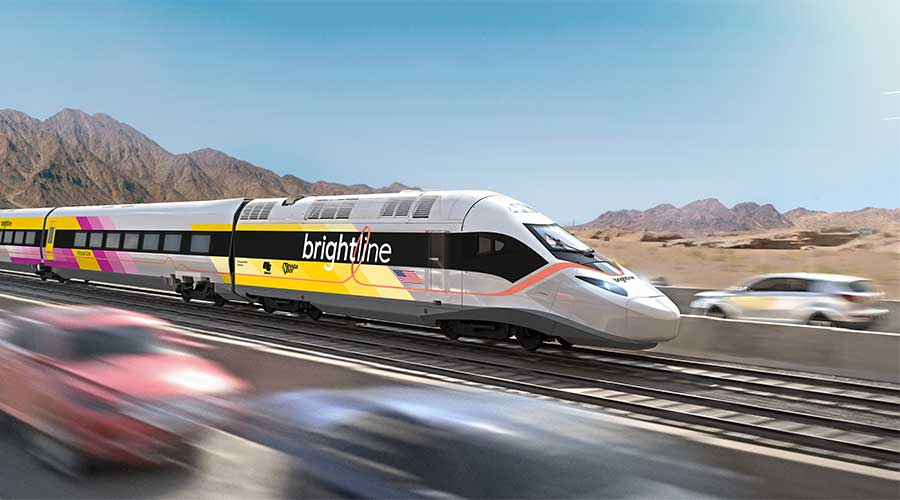Stay updated on news, articles and information for the rail industry
October 2015
Part 1 : Progressive Railroading's Passenger Rail at a Glance 2015: Preface
Part 3 : Progressive Railroading's Passenger Rail at a Glance 2015: Colorado, Florida and Georgia
Part 4 : Progressive Railroading's Passenger Rail at a Glance 2015: Illinois and Missouri
Part 5 : Progressive Railroading's Passenger Rail at a Glance 2015: New Jersey, New York, and Ohio
Part 6 : Progressive Railroading's Passenger Rail at a Glance 2015: Oregon and Pennsylvania
Part 7 : Progressive Railroading's Passenger Rail at a Glance 2015: Texas
Rail News: Passenger RailProgressive Railroading's Passenger Rail at a Glance 2015: Oregon and Pennsylvania
OREGON
Tri-County Metropolitan Transportation District of Oregon (TriMet)
TriMet provides light rail, commuter rail and bus service in Portland, Ore.
Service launched: Light rail in 1986; commuter rail in 2009
Route miles: 60 light rail; 14.7 commuter rail
Rolling stock: 149 light-rail vehicles, average age 14 years
Annual ridership: 37,682,800 light rail, 475,180 commuter rail in FY2015
Annual operating cost: $17.5 million for light rail, $6.5 million for commuter rail
Annual capital cost: NA
Number of stations: 60 light rail; 5 commuter rail
Major projects this year included the opening of the MAX Orange Line on Sept. 12, which was designed to improve transit along the corridor that extends from the terminus of the MAX Green and Yellow lines at Portland State University in downtown Portland to South Waterfront, Southeast Portland, Milwaukie and North Clackamas County. The $1.49 billion project features 10 new MAX stations for a total 97 systemwide, and will expand the MAX system to 60 miles. Stacy and Witbeck Inc. is the lead contractor.
Also, the project includes Tilikum Crossing, which is a first-of-its-kind multimodal bridge in the United States that carries light-rail trains and streetcars, buses, bicyclists and pedestrians, but no private vehicles.
PENNSYLVANIA
Southeastern Pennsylvania Transportation Authority (SEPTA)
SEPTA is the nation's sixth-largest public transportation system with an extensive network of fixed route services that includes subway, trolley, high-speed and regional rail serving a 2,202-square-mile service region.
Service launched by mode: Light rail in 1969; heavy rail in 1968; and commuter rail in 1983.
Route miles per mode: light rail, 42 one-way miles; heavy rail, 37 one-way miles; commuter rail, 280 one-way miles
Rolling stock: eight locomotives, average age 27 years; 942 light-, heavy and commuter-rail cars, average age is 28 years
Annual ridership: 31.9 million light rail; 36.7 million heavy rail, 96.5 million commuter rail
Annual operating cost: NA
Annual capital cost: NA
Number of stations: 53 light rail, 75 heavy rail, 153 commuter rail
Capital improvement projects underway or slated to begin within the next year:
• Bridges. SEPTA owns and operates on 287 bridges on the Regional Rail system. At an average age of 84 years or older, many of the bridges have been in service longer than their original intended service life. New state funding is allowing SEPTA to proceed with a $327 million, 10-year program to bring some of its bridges into a state of good repair. Notable ongoing bridge rehabilitation projects include: Media Viaduct program, three structures at a $35 million cost with Neshaminy Contractors as the major contractor; Chestnut Hill West Bridge 0.35 at a $10.3 million cost with RCC North Jersey as the contractor; and the first phase of a stone arch rehabilitation program involving nine structures at a cost of $8.3 million.
• Crum Creek Viaduct. SEPTA is replacing a 925-foot long, 100-foot-high steel viaduct that was constructed in 1895. Cost: $89.9 million. Contractor: Walsh Construction.
• Substation program. SEPTA’s 36 kV 25 Hz electric commuter-rail service is powered by an electrical distribution system originally built by the Reading and Pennsylvania Railroads in the 1920s and 1930s. Most substations on SEPTA’s commuter-rail system have been running continuously for more than 80 years. SEPTA is replacing the Jenkintown Substation at a cost of $34 million; overhauling Ambler at $10 million; Lenni, $9.1 million; Morton, $9.1 million; and Doylestown, $1.7 million.
Major projects with contracts yet to be let as of Sept. 3:
• Frazer Rail Shop and Yard modernization. SEPTA is in the process of procuring new locomotives and a fleet of multilevel cars for the Regional Rail system. To accommodate the increased fleet size, SEPTA will renovate and expand the 35-year-old shop and yard. The initial phase will include significant earthwork and stormwater improvements at the 40-acre site to create space for additional yard tracks. A new vehicle washer will be constructed to accommodate the new cars. Transportation facilities will be modified for the employees to be stationed at this facility. Project budget: $99.3 million. Design has started; site work will be completed in January 2018, with all construction to be completed by 2019’s end.
• Elwyn to Wawa service restoration. SEPTA will restore service on the Media-Elwyn Regional Railroad Line from its current terminus at Elwyn Station to Wawa, Pa. An early action phase to stabilize embankments on sections of this line was completed in 2010. The next component of the 3-mile service restoration will involve significant infrastructure renewal, including retaining walls; the rehabilitation or replacement of nine bridges; the replacement of track, catenary and structures; and signals. The last component of this project is construction of a new station, 600-car parking deck and an intermodal connection. Project budget: $117.4 million. Construction on the infrastructure package is due to begin in late 2017.
Part 1: Progressive Railroading's Passenger Rail at a Glance 2015: Preface
Part 2: Progressive Railroading's Passenger Rail at a Glance 2015: Amtrak and transit agencies in Arizona & California
Part 3: Progressive Railroading's Passenger Rail at a Glance 2015: Colorado, Florida and Georgia
Part 4: Progressive Railroading's Passenger Rail at a Glance 2015: Illinois and Missouri
Part 5: Progressive Railroading's Passenger Rail at a Glance 2015: New Jersey, New York, and Ohio
Part 6: Progressive Railroading's Passenger Rail at a Glance 2015: Oregon and Pennsylvania
Part 7: Progressive Railroading's Passenger Rail at a Glance 2015: Texas
Keywords
Browse articles on TriMet Southeastern Pennsylvania Transportation AuthorityContact Progressive Railroading editorial staff.


 2025 MOW Spending Report: Passenger-rail programs
2025 MOW Spending Report: Passenger-rail programs
 Gardner steps down as Amtrak CEO
Gardner steps down as Amtrak CEO
 Guest comment: Oliver Wyman’s David Hunt
Guest comment: Oliver Wyman’s David Hunt
 Women of Influence in Rail eBook
Women of Influence in Rail eBook
 railPrime
railPrime







